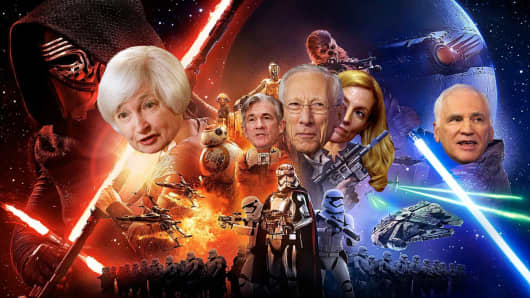A long time ago, in a galaxy far, far away…
On Dec. 16, two extraordinary things happened: “The Force” awakened and the Fed awakened. “Star Wars: Episode VII: The Force Awakens,” the first film of the series to be released in 10 years, opened with much fanfare — a cinematic masterpiece that has many seeing the space opera in a new light.
It even has me seeing monetary policy officials as characters of the epic space odyssey: a Jedi master named Janet Yellen roused the Federal Reserve, the most powerful monetary organization in the galaxy, after it had become dormant with its zero percent interest-rate policy. Jedi Janet learned from the mistakes of Yoda Greenspan who could have advised, “Low rates, you do not keep,” after he left rates too low for too long in the early 2000s. Wielding the light saber of data, Jedi Janet battled to balance the dual mandate of inflation and employment, and then awakened the Fed to raise rates for the first time in nine years, abandoning the dark side of a non-rules based monetary policy.
Both the Force and the Fed have enthralled the masses with their recent awakenings — and both have been largely successful.
In just under two weeks, “The Force Awakens” became the fastest movie to cross $600 million in box office revenue, eclipsing “Jurassic World,” which took five weeks to surpass that mark in 2015. In the coming days, “The Force” is expected to pass “Avatar’s” $760.5 million haul.
Remarkably, the new “Star Wars” film is already the fifth highest grossing film ever in North America. When you include the $624.7 million in international box office revenue, the total take stands at $1.22 billion. And the movie hasn’t even opened in China yet. But, according to Steven Spielberg, “The Force Awakens” Director J.J. Abrams is “terrified” because the film needs to surpass $1.5 billion to be deemed a success on Wall Street. Yet, according to one estimate, the movie could garner $2.7 billion.
The force is strong with this one.
In the words of Princess Leia Organa, “Somebody has to save our skins.” During and since the Great Recession, the Fed has saved our skins. Politicians in Washington, DC, should have passed a more aggressive stimulus bill to accelerate the recovery, but that didn’t happen, and the Fed understood the words of Yoda: “Do. Or do not. There is no try.”
Don’t be surprised if Jedi Janet gets cast in the next “Star Wars” movie — because even in this space opera, there’s room for central bankers. According to Wookieepedia, an online encyclopedia for all things “Star Wars,” the universal currency is known as the “Galactic Credit Standard.” This currency is backed by the minerals found on the planet Muunilinst also known as “Moneylend,” which is the headquarters of the InterGalactic Business Clan (IGBC), a group of bankers and lawyers, which oversee the intergalactic economy. But even in “Star Wars,” there are monetary problems: because the currency is backed by metals, there have been times when it wasn’t accepted, like during the Clone Wars.
During times like this, “Star Wars” would benefit from a Jedi master who could instill faith in its financial system. This far away galaxy needs Jedi Janet who knows exactly when to awaken The (monetary) Force.
[This article was also published in CNBC]
Commentary by Kabir Sehgal, author of the New York Times bestseller Coined: The Rich Life of Money And How Its History Has Shaped Us. He is a former vice president at JPMorgan and Grammy-winning producer. Follow him on Twitter @kabirsehgal.

0 Comments